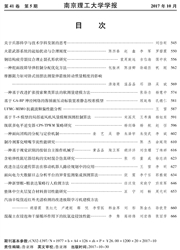

 中文摘要:
中文摘要:
针对利用视觉图像技术检测O形(密封)圈这类全向曲面特征零件的表面缺陷时存在曲面成像一致性差的难题,研究了曲面成像基础理论和航天系统用O形圈表面成像及其表面缺陷的全自动检测方法。首先,把O形圈表面划分为细小网格状的曲面小块,基于曲面小块的双向反射分布函数得到点光源辐照时曲面小块的辐射强度计算公式。然后,通过半球积分求得空间连续光源辐照条件下曲面小块的辐射强度计算方法。最后,结合O形圈曲面方程,建立了O形圈表面成像理论,并据此提出基于三镜头相机组的O形圈表面缺陷成像检测方法。对O形圈弧段曲面的成像实验表明:理论计算的亮度分布与实际亮度分布一致,垂直安装的镜头相机组对应的平均亮度误差为6.8,标准差为12.6;倾斜安装的镜头相机组相应的平均亮度误差最大为19.4,标准差为10.3;缺陷检测实验表明,所提方法能可靠检测出O形圈表面任意位置的缺陷,能够实现航天密封圈的全自动可靠检测。
 英文摘要:
英文摘要:
When machine vision technology is used to detect the surface defects of parts with omnidirectional curved surface characteristics such as‘O'sealing rings,it shows a poor consistency of surface imaging.To achieve the full-automatic and reliable detection of surface defects of‘O'rings used in aerospace systems,the curved surface imaging theory and the surface defect detecting methods of‘O'rings were investigated.Firstly,the surface of‘O'ring was divided into small pieces like small grids.Based on the bidirectional reflectance distribution function of surface pieces,the radiation strength calculation formula of surface pieces was derived under the condition of point light irradiation.Then,the radiation strength calculation method of surface pieces suitable for the space continuous light irradiation was obtained through a hemisphere integral.Finally,combining with the‘O'ring surface equation,the imaging theory of‘O'ring surface was established and the imaging anddetecting methods for‘O'ring surface defects based on three lens camera units were proposed.The imaging experiment results of the segmental arc surfaces of‘O'rings indicate that the theoretical brightness distribution is consistent with the actual brightness. The average brightness error corresponding to the vertical lens camera unit is 6.8and its standard deviation is 12.6.The maximum average brightness error corresponding to the gradient lens camera units is 19.4and its standard deviation is 10.3.The defect detecting experiment results show that the proposed method detects reliably the defects in any location of the surface of ‘O'rings and the proposed detecting system implements the automatic detection of the sealing rings in aerospace systems.
 同期刊论文项目
同期刊论文项目
 同项目期刊论文
同项目期刊论文
 期刊信息
期刊信息
